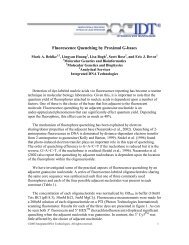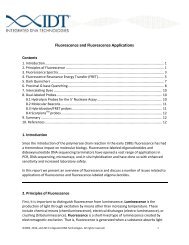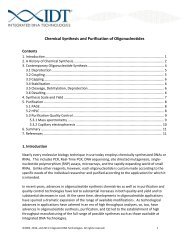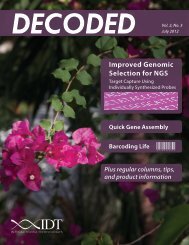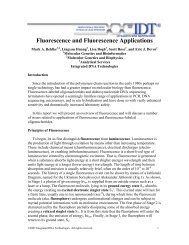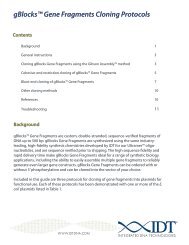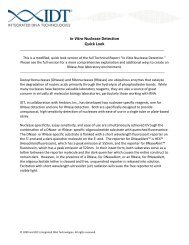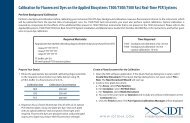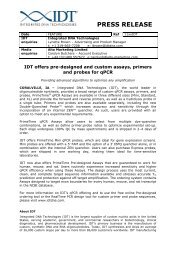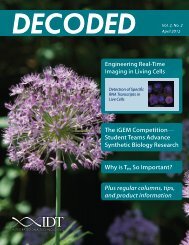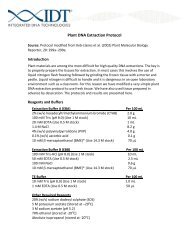Improved Print and QC Methods for Oligonucleotide Arrays
Improved Print and QC Methods for Oligonucleotide Arrays
Improved Print and QC Methods for Oligonucleotide Arrays
You also want an ePaper? Increase the reach of your titles
YUMPU automatically turns print PDFs into web optimized ePapers that Google loves.
INTRODUCTIONThe development <strong>and</strong> use of microarrays <strong>for</strong> expression profiling has enabled researchers toinvestigate gene expression across entire genomes in a single experiment. Several competing microarrayplat<strong>for</strong>ms are currently available. These plat<strong>for</strong>ms differ in both type <strong>and</strong> length of immobilized probesas well as in manufacturing technologies, from light-mediated in situ synthesis of oligonucleotides tospotting pre-made oligos or cDNA/PCR products via contact <strong>and</strong> non-contact methods. Common to allplat<strong>for</strong>ms is the fact that the accuracy <strong>and</strong> reliability of the conclusions derived from microarrayexperiments are dependent on the initial quality of the arrays. For arrays manufactured using spottingtechnologies, much attention has been given to the development of slide surfaces, attachment chemistries,<strong>and</strong> spotting solutions. The overall goal is to produce arrays with high sensitivity <strong>and</strong> low variability byoptimizing immobilized probe-density, probe availability <strong>for</strong> hybridization, <strong>and</strong> spot-signal homogeneity.Consequently, assessing array quality <strong>and</strong> comparing the per<strong>for</strong>mance of the competing manufacturingoptions have become crucial to ensure the use of the most robust <strong>and</strong> reliable reagents. Many reagents<strong>and</strong> methods are available <strong>for</strong> array spot <strong>QC</strong> analysis, from ssDNA binding stains (such as POPO-3 orSYBR®-Green II) to fluorescently labeled r<strong>and</strong>om-sequence oligomers. The ssDNA binding stains canassess spot presence <strong>and</strong> morphology but do not assess the functional ability of the immobilized probes tohybridize. The current consensus is that better assessment of microarray quality can be achieved throughhybridization of a fluorescent-labeled oligo.To determine the most reliable <strong>and</strong> robust combination of slide-surface chemistry <strong>and</strong> nucleic acidprobe design, we spotted a test set of eight oligo-probes with different GC-contents using different printbuffer compositions on commercially available epoxy, aldehyde, <strong>and</strong> amine surfaces. Each probe wassynthesized with a hydroxyl (unmodified), amino-modifier, or hydrazide-modifier group on the 5’-end.Hybridization with complementary oligomers showed highest signal intensity <strong>for</strong> the combination ofhydrazide-modified oligonucleotide printed on an amine-derivatized surface. We optimized the printbuffer composition to exploit this attachment strategy <strong>and</strong> tested the method on three different amineslides.Our overall best results were achieved by printing hydrazide-modified oligos on Corning GAPSIIslides in a buffer of our own <strong>for</strong>mulation (OSB, or <strong>Oligonucleotide</strong> Spotting Buffer). In addition, wesynthesized a new modified Cy3-labeled r<strong>and</strong>om 9-mer oligo <strong>for</strong> array <strong>QC</strong> <strong>and</strong> developed an optimizedhybridization method that results in improved detection of spotted oligo probes over a broad range ofGC-content.METHODSOligo <strong>Arrays</strong>Eight 70mer probe-oligo sequences with various 5’-modifications <strong>and</strong> two with different postsynthesispurifications (see Table 1) were printed in replicates using the GMS-417 Arrayer (Affymetrix).The oligo probes were spotted at either 25µM or 30µM in various spotting solutions (see Table 2) on fivecommercially available surfaces (see Table 3). The printed arrays were placed in a humidity chamber <strong>for</strong>3-4 hours <strong>and</strong> stored in a dark, dry (



